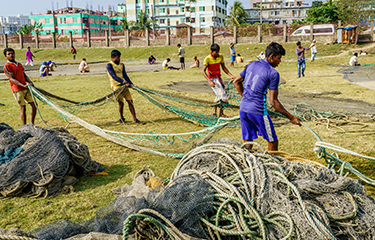The Food and Agriculture Organization of the United Nations projects that global seafood consumption will reach a level of 21.5 kilograms per capita in 2030, and thereby maintain a year-on-year growth trend that has already spanned 60 years, with increased fisheries and aquaculture production and growing market demand fueling the rise.
According to the FAO’s latest report “The State of World Fisheries and Aquaculture 2020,” also referred to as “SOFIA 2020,” per capita food fish consumption grew from 9 kilograms (live weight equivalent) in 1961 to 20.5 kilograms in 2018, equating to around 1.5 percent growth each year. At the same time, since 1961, the average annual rise in global food fish consumption of 3.1 percent has outpaced the population growth of 1.6 percent, and exceeded the consumption escalation of all other animal protein foods (like beef, poultry, and milk), which increased by 2.1 percent per annum.
SOFIA further highlights that in 2017, fish consumption accounted for 17 percent of the world population’s intake of animal proteins, and 7 percent of all proteins consumed. As such, the FAO calculates that fish provided more than 3.3 billion people with 20 percent of their average per-capita intake of animal proteins, and in some cases – such as Bangladesh, Cambodia, the Gambia, Ghana, Indonesia, Sierra Leone, Sri Lanka, and several small island developing states – it contributed 50 percent or more.
Despite persistent differences in the levels of fish consumption between regions and individual states, the report identifies some defining trends between developed and developing nations. It finds that in developed countries, apparent fish consumption increased from 17.4 kilograms per capita in 1961 to peak at 26.4 kilograms per capita in 2007, and gradually declined thereafter to reach 24.4 kilograms in 2017.
In developing countries, though, apparent fish consumption significantly increased from 5.2 kilograms per capita in 1961 to 19.4 kilograms in 2017, at an average annual rate of 2.4 percent. Among these, the least-developed countries increased their consumption from 6.1 kilograms in 1961 to 12.6 kilograms in 2017, at an average annual rate of 1.3 percent. This rate has increased significantly in the last 20 years, reaching 2.9 percent per year, because of expanding fish production and imports.
In low-income food-deficit countries, fish consumption increased from 4 kilograms in 1961 to 9.3 kilograms in 2017, a stable annual rate of about 1.5 percent.
Fast-forward to 2030 and the FAO’s 2030 projection for the seafood landscape in a decade’s time, it forecasts that world fish consumption will be 18 percent or 28 million metric tons (MT) more than in 2018, although it notes that the annual growth rate of this consumption will be slower over the coming 10 years at 1.4 percent, compared with 2.6 percent for the period 2007 to 2018. The slowdown will mainly be due to reduced production growth, higher prices, and a deceleration in population growth.
SOFIA further anticipates that about 71 percent of the world’s fish available for human consumption in 2030 – some 183 million MT – will be consumed in Asia, while the lowest quantities will be consumed in Oceania and Latin America. Total food fish consumption is expected to increase in all regions and subregions by 2030 in comparison with 2018, with higher growth rates projected in Latin America (33 percent), Africa (27 percent), Oceania (22 percent), and Asia (19 percent).
However, the world per capita consumption of fish paints a slightly different picture. Through 2030, this will increase in all regions except Africa, which will experience a decline of 3 percent. The highest growth rates are projected for Asia (9 percent), Europe (7 percent), and Latin America and Oceania (6 percent each).
In Africa, the per capita fish consumption is expected to decrease by 0.2 percent per year up to 2030 – from 10 kilograms in 2018 to 9.8 kilograms in 2030. The decline will be greater in sub-Saharan Africa, from 8.9 kilograms to 8.1 kilograms. SOFIA explains that the main reason for this drop is the growth of Africa’s population is outpacing the growth in supply, with an expected 13 percent increase in domestic production over the period 2019 – 2030 and increased fish imports unable to meet the region’s growing demand.
The share of imports of fish for human consumption in total food fish supply is expected to grow from 37 percent in 2018 to 40 percent in 2030. But this increase, together with the expansion of aquaculture production (by 48 percent in 2030 compared with 2018) and capture fisheries production (by 5 percent), will only partially compensate for the population growth.
One of the few exceptions will be Egypt, as the country is expected to further increase its already substantial aquaculture production.
The FAO said the projected decline in per capita fish consumption in Africa raises food-security concerns because of the region’s high prevalence of undernourishment and the importance of fish in total animal protein intake in many African countries. It said the decline may also weaken the ability of more fish-dependent countries to meet nutrition targets laid out in the United Nations' Sustainable Development Goal 2 to achieve “zero hunger.”
SOFIA estimates that global fish production reached about 179 million MT in 2018. Of this total, 156 million MT was used for human consumption. The remaining 22 million metric tons were destined for non-food uses, mainly to produce fishmeal and fish oil. Aquaculture accounted for 46 percent of the total production and 52 percent of fish for human consumption.
Photo courtesy of Alexey Stiop/Shutterstock







